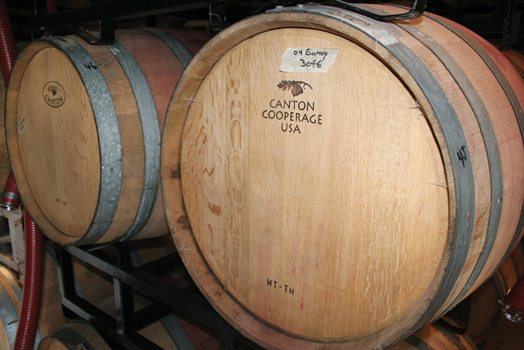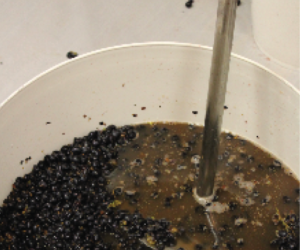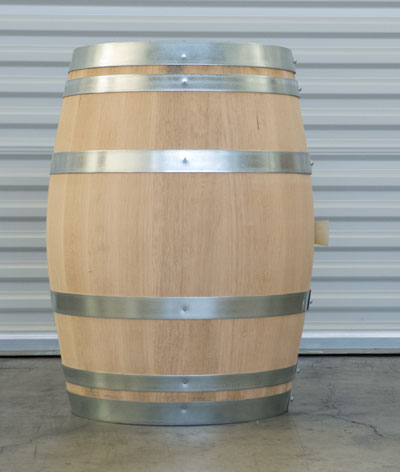
Q
In a recent issue of WineMaker, I read with some alarm your caution against burning sulfur sticks in a wet barrel. Not only did I make that error (in three beautiful, one-year-old recoopered French oak barrels), I also accidentally dropped one of the burning sticks into one of the damp barrels and heard it fizzle and sizzle. I managed to fish out that charred sulfur stick, but now what? If we assume that all this resulted in at least some sulfurous acid in the three barrels, is there any way to reverse the error and save the barrels?
Richard Steinberg
Los Altos, California
A
I think your barrels should be salvageable. Since you fished out the sulfur stick and are aware that you might have some residual sulfurous acid hanging about, you’ve already won half the battle; you know you need to do something to neutralize any acid in there. I would imagine you could get rid of most remaining sulfurous acid in your barrels by doing the following:
1. Put on protective goggles (as we all should when dealing with sanitizing solutions or chemicals).
2. Rinse a barrel well with water (warm or cold is OK, hot not needed) and drain the water out the bung hole. If your barrel still has pieces of the sulfur sticks or any other kind of solid residue inside the barrel you can see, you need to get it out. One of my favorite tricks is to feed a length of stainless steel chain (about 2 feet/60 cm long) into the barrel, add about 2 gallons (~8 L) of warm water, bung the barrel up and rock back and forth vigorously to help scour the sides. If you have heavy leesy solids that are dried on (though you should rinse these out prior to storage) sometimes the only thing you can do is fill the whole barrel up with water to soften these solids. If you have some kind of a very long-handled scrub brush that can reach interior spots, that can be helpful too. When the inside of the barrel is completely free of solids, proceed to the next step.
3. Introduce a basic sanitizing solution into each barrel to neutralize the sulfurous acid, using about three tablespoons of PeroxyClean, TriSodium Phosphate (TSP) or soda ash to 3 gallons (11 L) of water. Allow solution to contact all parts of the barrel by rocking back and forth, turning the barrel on its ends, etc. Do this for about five to ten minutes and drain.
4. Rinse well with water again and let drain for about three to five minutes.
5. Introduce a slightly acidic solution made with 3 tablespoons of food-grade citric acid to about 3 gallons (11 L) of water. This is to help neutralize any residue from your basic solution.
6. Citric acid is a food-grade and “friendly” acid that, with the above quick contact time, will do its job of neutralizing the basic chemical you added without soaking into the wood of the barrel with any level of significance, especially as you’re following with another water rinse right away in the next step below.
7. Rinse well with water and drain again. You are ready to fill!
Q
I seem to have extracted too much tannin during primary fermentation of my Cellar Craft Carmenère kit because the must is quite tannic and bitter. This is probably because instead of just punching down, I also squeezed the bag containing the grape solids (grape pack that accompanied the wine kit) once/day. I did this with a large stirring spoon, squeezing the bag repeatedly against the inside of the primary pail. This wine is currently in secondary fermentation, but I’m wondering if there is anything I can do to reduce the tannins short of waiting for several years for it to hopefully mellow out. Is there anything you can recommend to reduce the tannins of this current batch to a reasonable level?
Mark Kincy
Burke, Virginia
It seems to me like your Carmenère is a candidate for one of the “Wine Wizard’s” cheapest, easiest and most favorite ways to improve a tannic wine; egg white fining! What could be simpler (or more traditional) than grabbing an egg or two from the fridge. Egg whites are mostly made up of a pure protein called albumen, which has been used by winemakers for centuries to clarify, settle and lessen the tannin content in their wines. Depending on how much you add, the egg whites will cling to an increasingly large amount of the bitter and tannic elements in your wine and, as the protein molecules stick together and get bigger, they will eventually become so heavy as to fall to the bottom of your carboy, barrel or tank, effectively forming a layer of sediment at the bottom off of which you can rack the cleaned-up and less-tannic wine.
Sometimes wines just need a little bit of added egg white to get the desired effect, say like a Pinot Noir. Heavier reds tend to need a heavier hand, and Carmenère can sometimes be a beast. I’ve had lighter-style Carmenères but it sounds like you’ve got one with significant tannin. Since I don’t know how large your kit size is (the Cellar Craft website says they range from 7.5-16 L) and can’t taste your wine, all I can give you is an approximate range of addition. As a reader of my column, you know I’m a proponent of people doing bench trials first, that is, treat a small amount (say 1L or even 100 mLs) of their wine first with a proportionately small amount of their desired additive. This way you can fine-tune the amount of an additive you want to introduce to get the desired effect but without over-doing it.
My guess is that you’re going to want to add around 5 mLs egg white per liter or so of wine, since you do seem to have some pretty tannic wine. It doesn’t hurt to start there. You can always add more if you need to, that’s the beauty of egg white fining. If you have 100 mL graduated cylinders and some small pipets (little tubes with measured graduation on the side, which allow you to suck up and dispense small amounts, even fractions of a millileter of liquid) you could even do bench trials in 100 mL sizes, and try 0.5 mLs per 100 mL of wine. Then try more and possibly less to see if you like a better effect. Whether you do a bench trial first or just choose to treat the whole lot, here’s the basic procedure:
• Carefully break your egg open and separate the yolk from the white. Save the yolks for something else, perhaps crème brûlée?
• Measure out the desired amount of egg white. Add a pinch of table salt per egg white used. If the egg is too viscous or difficult to measure, sometimes I agitate them gently with a fork first, without aerating, to break up the ropy proteins. The idea is to distribute the egg white, not to create a foam.
• For every egg white used, add about 2–3 mLs of water to help further “liquefy” the egg white and form it into a solution you can measure.
• Measure this solution (taking into account how much water you added) and add the desired amount (if you’re doing bench trials, use your pipets here) to your wine.
• Gently stir the wine with the egg white solution added, for about 1–5 minutes or until you feel the container has received a good mix. A 100 mL bench trial would take about 20 seconds whereas a barrel would take about three minutes with a big barrel-stirring wand (the kind with a blade on the bottom).
• Cover up or bung up your container of wine and let the egg whites do their thing; they will naturally glom on to the tannins and bitter phenolics and will form a layer of fluffy solids at the bottom of your container.
• After about two weeks, carefully rack your clarified wine off of this layer and voila! You can always taste a sample from the top of the container after about a week of settling to check if you think you’ve added enough egg white. If not, dose the container again with some additional egg white, stir and let settle out again until you are happy.
Other proteins to try (which remove tannins and bitterness) include products that contain gelatin, isinglass or casein (milk protein). There are lots of different commercial preparations available to winemakers online or in their local home brewing shops, but since I always have eggs around the house I tend to head there first.
Q
I always put my Zinfandel through malolactic fermentation. The manufacturer’s instructions say the wine should be less than 15 ppm. Isn’t that risking spoilage? I add about 1/4 tsp of sulfite per 5 gallons (19 L) when I crush, and this usually results in about 25 ppm after primary fermentation. So, I usually rack and wait until it lowers to 15 ppm. Is this safe?
Frank Dimatteo
Kensington, Connecticut
A
Since you don’t mention whether the 15 ppm is free or total SO2, it’s tough for me to refer specifically to either the instructions or your protocol. However, I routinely add up to 30–40 ppm total sulfur dioxide to my reds pre-primary fermentation and then inoculate with my ML bacteria after the wine is dry (from a residual sugar point of view). Since free sulfur dioxide binds readily to sugars and aldehydes, by the time primary fermentation is over, your free SO2 is essentially zero. This makes for a relatively safe environment for your ML bacteria of choice, which are not affected by bound SO2 at that concentration. If you’re keeping your pre-fermentation sulfur additions to a reasonable level, there’s no reason to wait, as you suggest above, before you add your ML bacteria because post-primary the levels of free (biologically active and therefore available to interact with the ML bacteria) sulfur dioxide will have dropped to a safe (negligible) level.
You’re right to hint that leaving long periods of time at low levels of sulfur dioxide is risky for wine. You never want to leave your wine unprotected. A rule of thumb for me is that if it doesn’t have at least 25 ppm free SO2 a wine has to be going through either primary or secondary fermentation and therefore producing carbon dioxide gas for me to feel comfortable. This means that I get primary going quickly, after that’s dry inoculate with my ML bacteria and get that going, and then when that is determined “dry” I add enough total sulfur dioxide to maintain a free sulfur dioxide of 25–30 ppm. Check your free SO2s at least every two months, adding more with topping as needed, because free SO2 eventually gets bound up as total SO2 and loses its effectiveness. The lactic acid bacteria (LAB) for MLF is also sensitive to total SO2, so be sure to follow the manufacturer’s instructions carefully.







